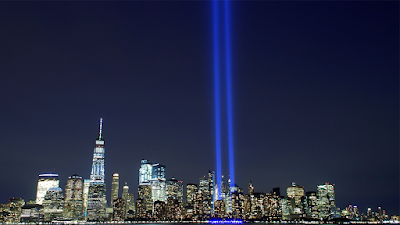I remember a time in my teen years when my mom was talking about the Kennedy assassination. She had very vivid memories of the time, and was surprised that my brother didn't seem to know anything about it. Then my brother reminded her he was barely a year old when it happened.
While many of us have clear memories of 9/11, it is sometimes difficult to grasp that none of the students we currently serve at Southeast Polk were even born when 9/11 happened. (I had to sit with that for a minute). For many adults, 9/11 is a very personal experience. For our students, it is truly history. And for our new generation of teachers, it is somewhere in between. Today's blog provides both resources and contexts for teaching students about this day, including the impact and significance of the event and how it has shaped our world.
This site offers interactive lesson plans for students in grades 3-12 that addresses the 9/11 attacks, their ongoing repercussions, and the history of the World Trade Center.
Below are just a few examples of the lessons for different grade levels. See the full site (linked above) for more lesson ideas.
Theme: Memorializing 9/11
Grade Level: 3-5
Essential Question: What is a hero and how can people show gratitude to those who act heroically in their own communities.
Theme: Antecedents of 9/11
Grade Level: 6-12
Essential Question: Why were the World Trade Center, Pentagon, and U.S. Capitol targeted on 9/11?
The International Fight Against Terrorism
Theme: Repercussions of 9/11
Grade Level: 9-10
Essential Question: How did other nations assist the United States in the immediate search for Osama Bin Laden?
PBS
Ways to reflect on the day's legacy more that two decades later.
Grade Level: 7-12
Learning Goals
- Understand the history and impact of the 9/11 attacks
- Construct critical questions around the anniversary of 9/11 and its present-day context
- Evaluate and reflect on personal understandings of 9/11 through critical questions.
- 14 Cows for America by Carmen Agra Deedy (Pre-K–3)
- Branches of Hope by Ann MaGee (Pre-K–2)
- 30,000 Stitches by Amanda Davis (Grades K–3)
- America Is Under Attack by Don Brown (Grades 1–5)
- Fireboat: The Heroic Adventures of the John J. Harvey by Maira Kalman (Grades 3–5)
- Nine, Ten: A September 11 Story by Nora Raleigh Baskin (Grades 3–8)
Hear First-Person Accounts
Every year, the September 11 Memorial & Museum shares a film featuring first-person accounts of the attacks that can be viewed in the classroom to start a discussion on this difficult topic. The program will be interpreted in American Sign Language, captioned, and can be played with Spanish subtitles. You can sign your class up for an interactive live chat where students can pose questions to museum staff. Past videos included a firefighter who responded to the World Trade Center on 9/11; a police officer who was rescued from the debris at Ground Zero; and a student who attended the Florida elementary school where President George W. Bush was first informed of the 9/11 attacks. There is an option for teachers to preview the content before sharing the video.
After watching the video, hold a class discussion using guided questions, such as:
- What did you learn about 9/11 from the person’s story?
- Why do you think the 9/11 Museum took a video of people talking about their experience on September 11?
- How do first-person accounts help us learn about history?
- What questions do you still have after hearing the person’s story?
Conduct an Interview
Tell students that primary documents make history come alive. Here’s how to teach students about primary sources and why they are important. Make sure students understand the difference between primary and secondary sources.
Next, explain to students that they are going to interview an adult about their memories of 9/11. Once they know who they will interview, they should decide if the person is a primary source or secondary source. Tell them to do an audio or video recording of the interview. Brainstorm with students a list of questions they might ask, such as:
- What do you remember about the 9/11 terror attacks?
- How has the world changed as a result of 9/11?
Afterwards, have students write a paragraph describing what they learned about 9/11 and its impact. This blog on how to write expository paragraphs can guide them. Finally, invite students to share their reflections with the class.
BACKGROUND RESOURCES
Teaching And Learning About 9/11 With The New York Times
The New York Times archive of reporting and multimedia.
September 11 Digital Archive
More than 150,000 digital items: emails, first-hand stories, and images
APPROACHES TO TEACHING
How To Teach 9/11 To Students With No Memory Of It
Addresses the change from teaching as current event to teaching as history.
Teaching Sept. 11 To Students Who Were Born After The Attacks Happened
Stresses the need for teaching the event and its aftermath in all its complexity.
How To Talk About 9/11 With A New Generation Of Kids
Teachers struggle with whether and how to teach the attacks and their aftermath.
Making 9/11 Relevant to Young Learners
Examines how teachers can make 9/11 relevant to young learners.
.jpg)




No comments:
Post a Comment